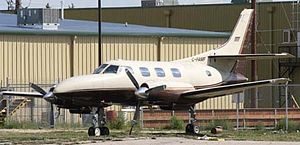Swearingen Merlin
| Merlin | |
|---|---|
 |
|
| Swearingen SA226-T Merlin III C-FAMF Perimeter Aviation, Winnipeg c. 2007 | |
| Role | Business aircraft |
| Manufacturer |
Swearingen Fairchild Aircraft |
| Designer | Ed Swearingen John T. Jennings |
| Status | Out of production, in service |
| Produced | 1965-1998 |
| Unit cost |
$442,000 (1969 Merlin IIB)
|
| Variants |
Fairchild Swearingen Metroliner C-26 Metroliner |
The Swearingen Merlin or the Fairchild Aerospace Merlin is a pressurised, twin turboprop business aircraft first produced by Swearingen Aircraft, and later by Fairchild at a plant in San Antonio, Texas.
The Merlin was an evolution of earlier modification programmes performed by Swearingen Aircraft. Ed Swearingen started the developments that led to the Merlin through gradual modifications to the Beechcraft Twin Bonanza and Queen Air business aircraft which he dubbed Excalibur. Then a hybrid aircraft was developed, with a new fuselage and vertical fin, mated to salvaged and modified (wet) Queen Air wings and horizontal tails, and Twin Bonanza landing gear. This was the SA26 Merlin, more-or-less a pressurized Excalibur but fitted with a different model engine, the Lycoming TIGO-540 6-cylinder geared piston engine. The TIGO 540 was used despite the fact that one of the reasons the IO-720 was used in the Excalibur was that the Queen Air series' IGSO-480 and IGSO-540 engines from the same manufacturer were so troublesome. The decision was soon made to offer increased engine power, which was achieved through installing two Pratt & Whitney Canada PT6A-20 turboprop engines, resulting in the SA26-T Merlin IIA.
The prototype IIA took to the air for the first time on 13 April 1965, about fifteen months after the competing Beech Model 65-90 King Air (which was also derived from the Model 65 Queen Air). 36 Merlin IIA models were built before a follow-on model with Garrett AiResearch TPE-331-1 engines called the SA26-AT Merlin IIB entered production after AiResearch was appointed as distributor for the type. The TPE-331 became the definitive engine of all subsequent production Merlins and the longer-fuselage Metros that were to follow. The Australian Department of Civil Aviation (now the Civil Aviation Safety Authority) took delivery of four Merlin IIBs in 1969 and operated them for almost fifteen years. The Merlin IIAs and IIBs were visually still obviously derivatives of the Queen Air, featuring as they did Queen Air tailplanes and wings with the same flat-top engine nacelles as the Excalibur Queen Airs; the airstair in the same place and of the same general design as the Queen Air; and the nose being especially similar, of the same general shape with access panels the same size, shape and location as those of the Queen Air.
...
Wikipedia
